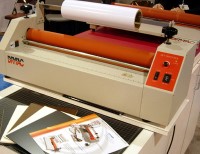 Photo 1
Photo 1
Drytac JetMounter JM26
Current trends in digital graphics, wide format inkjet in advertising and exterior fine art is rapidly expanding the marketing potential for custom framers beyond wall décor. Many businesses are already offering on-site image repair, modification and enlargements through digital printing and with many digital images being heat-sensitive, making rollers a logical addition. Many years ago I began stating the next equipment investment for every progressive framer would be the roller laminator (RL), and though it hasn't happened overnight, the time has come. Substrates have changed to accommodate larger, longer, wide format images and exterior display banners and billboards are far more commonplace, making traditional dry mount presses too limited for many mounting requirements.
Rollers are available as manual or automatic; for production or single mounting; with substrate thickness presets or variable thickness adjustments; as cold rollers for pressure-sensitive films; or with temperature controls for heat activated films. Whether a 44" cold or 80" hot/cold laminator, there are many decisions to be made prior to final selection and purchase.
Do Your Homework
Three basic considerations when purchasing an RL are 1) know your competition, 2) review all marketing potential, and 3) create a five year plan. Research who is offering large scale roller services in town, what types of images they handle, what substrates are they offering and pay attention to how they are marketing their services. Also try to determine who your big future clients might be, remembering that permanent bonding of an image to a rigid substrate is only one service. Your new RL should be full service so both mounting and laminating projects will be required to grow your business. Laminating applies polyester film—available smooth and textured—to the surface of an image for durability and are particularly useful for exterior signage. Encapsulation—two sided permanent lamination—coats both sides with film and could be applied to much smaller projects including menus, maps, bookmarks and such.
Finally, are you considering in-house wide format printing within the next five years? How large? Are these images to be commercial or fine art? Commercial printing will enhance the RL use while fine art printing only might limit the bonding and laminating needs for in-house production. Also consider the possibility of creating in-house pressure-sensitive mount boards for your own use as well as for other framers allowing to upgrade or change the color and preservation quality of the substrate. Being a subcontractor for other framers is always a potential market.
Cold vs. Hot
Heat activate (HA) rollers are available with nip openings adjustable from ⅜" to 2" wide using either manual or pneumatic adjustments. Cold rollers may adjust to paper thickness without a substrate for premounting of adhesive allowing for mounting flexibility and montage placement. Beginners prefer presets for speed and temperature, while experienced operators generally prefer the flexibility of adjustable pressure as well as nip presets. There are pros and cons to all systems so selecting the right one for you will depend on your future plans, service and budget.
The two things that make cold RLs the most valuable to framers is their potential for facemounting images to the back side of PMMA (acrylic sheeting) and mounting images to nonporous aluminum composite—DiBond—using high tack P-S film. If your five year plan does not include commercial applications of exterior signage and only a few images cold mounted weekly, a small tabletop Daige Solo 25", Drytac JetMounter™ JM26 (photo 1), GBC Arctic® 1040WF©, or Coda Cold-Mount® CML26 might be fine. Routine daily mountings would indicate the need for a larger roller perhaps the D&K 55Cold WF (photo 2) AMS Kool 55, JetMounter™ JM44SHA, Arctic 1064WF©, Seal® 44 Ultra Plus, Seal® 54EL, or Cold-Mount® CML44 (photo 3), which are all good entry level cold RLs. Coda's CML series are sold as pressure-sensitive cold laminators but are adaptable to heat-assist or thermal upgrades. Their CMP-MS models are motorized cold mount only units available up to 54" wide beginning at $1850 (photo 4).
 Photo 1
Photo 1
Drytac JetMounter JM26
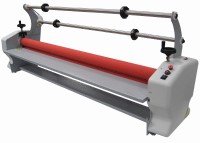 Photo 2
Photo 2
D&K 55 Cold WF
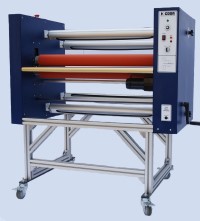 Photo 3
Photo 3
CLM 44
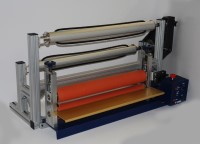 Photo 4
Photo 4
CMP Feed Takeup
"The most popular wide format laminator for framers is our EXP 42+ model. This is an entry-level to mid-range unit that seems to be a good fit for framers, both for size and price point. This lists for $5915 and can be used to mount and laminate prints up to 41wide with either cold/pressure-sensitive or heated/thermal laminates," says Brian Biegel, Marketing Communications Specialist, D&K Group, Inc. Look for features of easy load, safety, reset, speed, and pressure controls. Also consider routine maintenance and service after the sale.
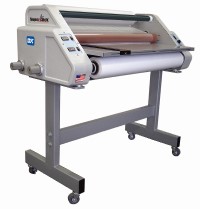 Photo 5
Photo 5
D&K EXP 42 Plus
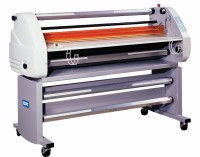 Photo 6
Photo 6
AMS 63WF wide-format
Thermal RLs have been used for decades in the sign and photo markets, but are less likely to fit a framer's needs. Size could be mandatory, but heat may not be. That said, if you are targeting large scale hot/cold roller applications then D&K EXP42 Plus (photo 5) or EXP62 Plus, AMS 63WF wide-format (photo 6), Drytac JetMounterJM63Pro (photo 7), Neschen Seal— 62Pro, or GBCTitan1264WF machines might be logical choices. Hot/cold RLs will mount and laminate all temps, all types of materials, but they also have limitations. Cold RLs are a more economical investment than heated machines, but the films are higher in price. Cold machines cannot encapsulate for exterior use, while hot rollers cannot facemount.
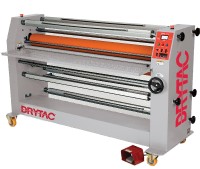 Photo 7
Photo 7
Drytac JetMounter™ JM63Pro
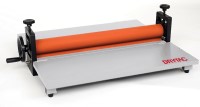 Photo 8
Photo 8
Drytac ML25
Drytac, Coda and Daige also offer low production, hand operated, tabletop models that are perfect for students, hobbyists, copy shops or an occasional pressure-sensitive mount here and there, but are really not wide enough for most framer needs. The Drytac ML25 (photo 8), Xyron Pro XM2500 25", CL-27 Cold Press with list prices beginning around $500, but these are limited in both width and overall function. Coda's economy hand operated CMP-HS models are available up to 34" and begin at $1050. As with the motorized laminators, these machines usually have adjustments for material thickness and roller pressure, which assists in the control of orange peel and application of P-S overlaminate films.
Pros and Cons
There are pros and cons to all systems—aside from price—so selecting the right one for you will depend on your future plans as well as immediate needs. Depending on who you opt to purchase from a basic motorized tabletop 25" cold laminator can run from $1,000 to $3,000. Cold or heat-assist models 42"-44" run $3,500 to $8,000, with thermal hot/cold machines 55"-65" machines running $5,200 to $20,000. Even larger models with more bells and whistles are available up to 80" wide, see manufacturers for details.
Cold Roller Laminators
Hot/Cold Roller Laminators
Determining Selection
Whether selecting a 44" cold or 80" hot/cold laminator, all production considerations must be made prior to purchase. There are dozens of laminators on the market as well and a variety of manufacturers. Laminators may be purchased through your framing distributor, online laminator company and sometimes direct from the manufacturer. It is important to take service-after-the-sale into consideration when purchasing motorized wide-format models. A simple hand crank press will not need service nor training, but a 62" hot/cold RL will no doubt intimidate you as much as your first hot vacuum press did.
To begin the selection process is good to ask yourself a series of questions to help narrow down the choices. This will determine why you want a roll laminator in the first place.
Mounting—permanently bonding—images to rigid substrates, both porous and nonporous, is the basic application. Laminating applies a surface coating of polyester film over images as a glass substitute. P-S and/or heat-set laminates are available in a variety of finishes and textures so you must consider all the options. Encapsulating is only available with heat-set films and a hot laminator.
To help determine the size of the RL best for you,
To determine cold or hot/cold RL,
To determine production machine or occasional use roller,
When finalizing any equipment purchase consider initial equipment purchase, shipping, set-up, service after the sale for on-going maintenance, education/training opportunities, and technical/customer support. Deciding whether or not it's time to buy an RL is only the tip of the iceberg, then you must determine what width, hot or cold, table or free-standing, and what you want to achieve with this new baby. In any event it must never turn into just another impressive paperweight—it must always earn its keep.
END
Copyright © 2013 Chris A Paschke
Resources—Items
http://drytac.com—JetMounter Roll Laminators 18"-63"
http://dkgroup.com—Expression 42" to 63" Laminators; Wide format; Pouch
http://lexjet.com—Seal 62"-80"; D&K 42"-65"; Daige; GBC 25"-80"
http://codamount.com—Coda Cold-Mount 14"-54"; Hot/Cold 26"-64"
http://sealgraphics.com—Seal 44"-80" Ultra, EL, Base and Pro series
http://artmaterialsservice.com—AMS 42" and AMS 63" hot (D&K EXP); AMS Kool 25"-65" (Daige Solo)
http://gbcconnect.com—GBC Arctic, Titan
http://laminator.com—Xyron; Drytac, Daige
For more articles on mounting basics look under the mounting section in Articles by Subject.
Additional information on all types of mounting is found in:
The Mounting and Laminating Handbook, Second Edition, 2002,
The Mounting And Laminating Handbook, Third Edition, 2008 and
Creative Mounting, Wrapping, And Laminating, 2000 will teach you everything you need to know about getting the most from your dry mount equipment and materials as an innovative frame designer.
All books are available from Designs Ink Publishing through this website.
Chris A Paschke, CPF GCF
Designs Ink
Designs Ink Publishing
785 Tucker Road, Suite G-183
Tehachapi, CA 93561
P 661-821-2188
chris@designsinkart.com